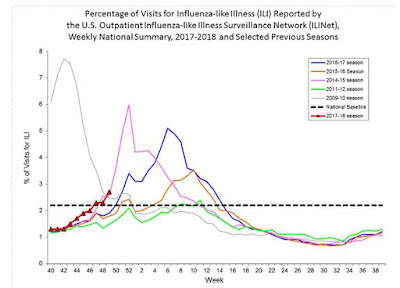 |
| Week 49 - Credit CDC FluView |
#12,969
With the usual caveat that the CDC's numbers reflect a snapshot taken a week ago - and by now flu may have spread further than the maps (above) would indicate - today's Fluview Report shows that influenza continues to rise, particularly in the southern states.
As the chart above illustrates, reports of influenza-like-illnesses (ILI's) are appearing fairly early, and on par with the early arrival we saw during the 2014-15 flu season.
The P&I Pneumonia and Influenza Mortality numbers remain well below the epidemic threshold, but these numbers reflect conditions in late November (Week 47) - and the CDC reports a backlog of data - meaning these numbers may need to be revised upward as more data comes in.
Today's report also contains the 67th novel swine variant infection report of 2017, making this the second busiest year ever recorded.Swine variant infections are generally mild or moderate in severity, and are indistinguishable from regular flu without a lab test. Most are linked to direct or indirect contact with swine, often at agricultural exhibits and county fairs.
Novel Influenza A Virus:
One human infection with a novel influenza A virus was reported by Iowa during week 49. This person was infected with an influenza A(H3N2) variant [A(H3N2)v] virus and reported direct contact with swine during the week preceding illness onset. The patient was an adult < 50 years of age, was not hospitalized, and has fully recovered from their illness. No human-to-human transmission has been identified.
A total of 67 variant virus infections have been reported to CDC during 2017. Sixty-two of these have been A(H3N2)v viruses (Delaware [1], Iowa [1], Maryland [39], Michigan [2], Nebraska [1], North Dakota [1], Ohio [15], Pennsylvania [1], and Texas [1]), one was an influenza A(H1N1) variant [A(H1N1)v] (Iowa [1]) virus, and four were influenza A(H1N2) variant [A(H1N2)v] viruses (Colorado [1] and Ohio [3]). Six of these 67 infections resulted in hospitalization; all patients have recovered.
Early identification and investigation of human infections with novel influenza A viruses are critical so that the risk of infection can be more fully understood and appropriate public health measures can be taken. Additional information on influenza in swine, variant influenza infection in humans, and strategies to interact safely with swine can be found at http://www.cdc.gov/flu/swineflu/index.htm. .
Although the Public Health risk from these swine variant viruses is considered low at this time, the CDC takes these emerging swine flu viruses seriously (see CDC Risk Assessment).
Other highlights from today's FluView report include:
2017-2018 Influenza Season Week 49 ending December 9, 2017
All data are preliminary and may change as more reports are received.Synopsis:
During week 49 (December 3-9, 2017), influenza activity increased in the United States.
(Continue . . . . )
- Viral Surveillance: The most frequently identified influenza virus type reported by public health laboratories during week 49 was influenza A. The percentage of respiratory specimens testing positive for influenza in clinical laboratories increased.
- Novel Influenza A Virus: One human infection with a novel influenza A virus was reported.
- Pneumonia and Influenza Mortality: The proportion of deaths attributed to pneumonia and influenza (P&I) was below the system-specific epidemic threshold in the National Center for Health Statistics (NCHS) Mortality Surveillance System.
- Influenza-associated Pediatric Deaths: One influenza-associated pediatric death was reported.
- Influenza-associated Hospitalizations: A cumulative rate of 4.3 laboratory-confirmed influenza-associated hospitalizations per 100,000 population was reported.
- Outpatient Illness Surveillance:The proportion of outpatient visits for influenza-like illness (ILI) was 2.7%, which is above the national baseline of 2.2%. Seven of the 10 regions reported ILI at or above region-specific baseline levels. Four states experienced high ILI activity; five states experienced moderate ILI activity; New York City, Puerto Rico, and 16 states experienced low ILI activity; 25 states experienced minimal ILI activity; and the District of Columbia had insufficient data.
- Geographic Spread of Influenza:The geographic spread of influenza in 12 states was reported as widespread; Puerto Rico and 26 states reported regional activity; 10 states reported local activity; the District of Columbia, the U.S. Virgin Islands and two states reported sporadic activity; and Guam did not report.
Despite concerns over less-than-stellar vaccine effectiveness this year, I would still urge anyone who hasn't gotten the shot to consider doing so immediately. Some protection beats no protection any day of the week. For more on the benefits of flu vaccination, you may wish to revisit:
More Evidence Flu Shots May Improve Outcomes In Critical Patients
Study: Flu Vaccine May Reduce Heart Attack Risk
CID Journal: Flu Vaccine Reduces Severe Outcomes in Hospitalized Patients
Lastly, as we head deeper into this flu season we all need to be paying special attention to practicing good flu hygiene; covering your coughs, washing your hands, staying home when you are sick, etc..
So, remember . . . .

